Chimie Inorganique
Magnetic nanosystems
Axis 3 - Single Molecule Magnets (SMMs) as multiple Qbits models
Giant Ising-type magnetic anisotropy in trigonal bipyramidal Ni(II) complexes
Thanks to the chelating organic ligand Me6tren, the mononuclear Ni(II) complex has a trigonal bipyramidal symmetry leading to a very large magnetic anisotropy along its three-fold axis; the largest, to date, for a Ni(II) complex. This complex behaves as a two-level molecule and may be considered as an electronic qbit
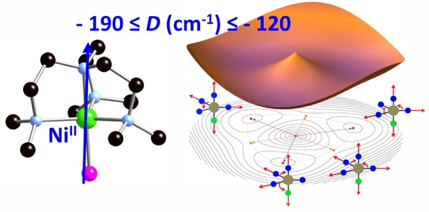
(left) View of the molecular structure of the trigonal Ni(II) complex with the main anisotropy tensor axes
(droite) Schematic representation of a moat around a Jahn−Teller C3 crossing showing the three symmetry-equivalent minima, the three-dimensional representation (the tricorn, top) and the equipotential contour plot (bottom)
Giant Ising-Type Magnetic Anisotropy in Trigonal Bipyramidal Ni(II) Complexes: Experiment and Theory. R. Ruampst, R. Maurice, L. Batchelor, M. Boggio-Pasqua, R. Guillot, A-L. Barra, J. Liu, E-E. Bendeif, S. Pillet, S. Hill, T. Mallah, N. Guihéry (2013) J. Am. Chem. Soc. 135 (8), 3017-3026
Ising-type magnetic anisotropy and single molecule magnet behaviour in mononuclear trigonal bipyramidal Co(II) complexes
The trigonal bipyramidal Co(Me6tren)Cl+ complex behaves as a SMM with an opening of the hysteresis loop at zero field at very low temperature. The magnetic loop has steps associated with the hyperfine coupling between the electronic and the nuclear spins as observed in the Tb(phtalocyanine)2 double decker complex that behaves as a qdit (with d = 4, because the nuclear spin of Tb ITb is equal to 3/2). The Co(II) complex may be considered as a qdit with d = 8 because ICo = 7/2.
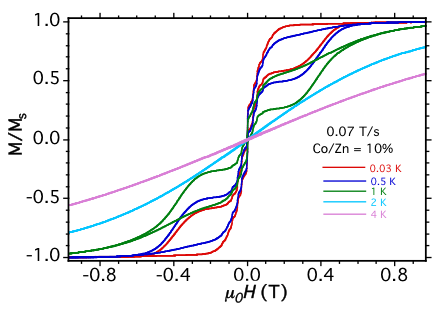
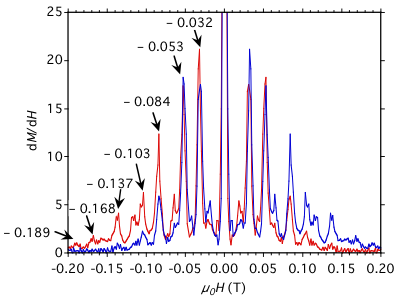
(left) Mmagnetization vs. field on a single crystal of [Zn0.9Co0.1(Me6tren)Cl](ClO4) with its easy axis aligned with the field at different temperatures. (droite) dM/dH = f(µ0H) at T = 30 mK showing the hyperfine coupling between the nuclear and the electronic spins
Ising-type magnetic anisotropy and single molecule magnet behaviour in mononuclear trigonal bipyramidal Co(II) complexes. R. Ruamps, L. Batchelor, R. Guillot, G. Zakhia, A-L. Barra, W. Wernsdorer, N. Guihéry, T. Mallah (2014) Chem. Sci. 5 (9), 3418-3424
Slow relaxation of the magnetization in an antiferromagnetically coupled Dy2 complex
Within the binuclear complex, the Dy(III) mononuclear has an Ising type anisotropy. In the molecular frame, the two anisotropy axes are oriented in a way to align their magnetic moments in an antiparallel fashion as depicted below. Despite the antiferromagnetic coupling, an opening of the hysteresis loop is observed at zero field due to the dynamic of the relaxation process within the binuclear complex.
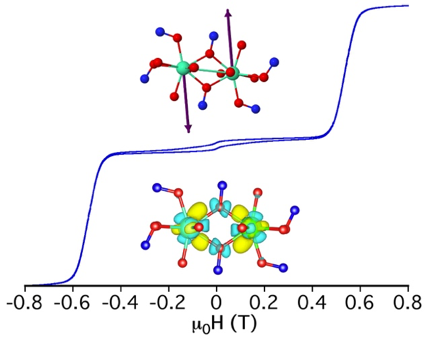
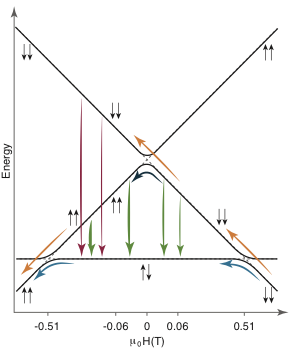
(gauche) Magnetization vs. field showing an opening of the hysteresis loop at zero field and the presence of an antiferromagnetic coupling between the two Dy(III) ions
(droite) Field-dependent energy diagram showing the different relaxation processes for the binuclear complex
Assessing the exchange coupling in binuclear lanthanide(III) complexes and the slow relaxation of the magnetization in the antiferromagnetically coupled Dy2 derivative. C. Chow, H. Bolvin, V. Campbell, R. Guillot, J. Kampf, W. Werndorfer, F. Gendron, J. Autschbach, V. Pecoraro, T. Mallah (2015) Chem. Sci. 6 (7), 4148-4159
Antiferromagnetically coupled SMMs as models for double qbits
We use cryptand like ligands with two coordination sites in order to prepare binuclear Co(II) and Ni(II) complexes with controlled large magnetic anisotropy and weak antiferromagnetic coupling. These species may be considered as coupled two-level systems and may play the role of double qbits
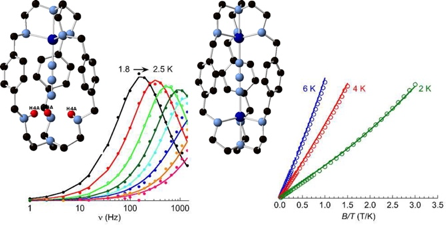
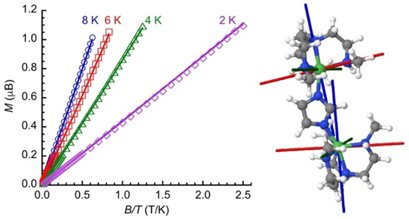
Crystal structure of a mononuclear Co(II) complex that behaves as a SMM and the corresponding binuclear species
A Ni(II) binuclear complex with large local magnetic anisotropy and weak antiferromagnetic coupling
Design and Magnetic Properties of a Mononuclear Co(II) Single Molecule Magnet and Its Antiferromagnetically Coupled Binuclear Derivative. F. El Khatib, B. Cahier, F. Shao, M. López-Jordà, R. Guillot, E. Rivière, H. Hafez, Z. Saad, J-J. Girerd, N. Guihéry, T. Mallah (2017) Inorg. Chem. 56 (8), 4601-4608
Design of a Binuclear Ni(II) Complex with Large Ising-type Anisotropy and Weak Anti-Ferromagnetic Coupling. F. El Khatib, B. Cahier, M. López-Jordà, R. Guillot, E. Rivière, H. Hafez, Z. Saad, J-J. Girerd, N. Guihéry, T. Mallah (2017) Inorg. Chem. 56 (17), 10655-10663
Last update on 06.21.2019
Fundamental studies of Ni(II)-based quantum bits
PhD student: Idris Tlemsani
Collaborations:
- Serge Gambarelli (RPE pulsée, CEA : Molecular Systems and nanoMaterials for Energy and Health, SyMMES, Grenoble)
- AnneLaure Barra (HF-RPE, Laboratoire National des Champs Magnétiques Intenses, Grenoble)
- Nicolas Suaud, Nathalie Guihéry, Hélène Bolvin (études théoriques, Laboratoire de Chimie et Physique Quantiques, Toulouse)
Related publications:
- Chemical Science, 2021, 12, 5123–5133
Magnetic molecules can play the role of qubit necessary for building a quantum computer. However, their use remains limited by their coherence time, which is the time during which they can retain information. Magnetic interactions, like the dipolar interactions between these molecules, are responsible for decoherence, and it is therefore necessary to reduce them. A simple way to reduce these interactions consists of moving the molecules away from each other, in particular by diluting them in a diamagnetic matrix. However, this also has the effect of limiting the ability of qubits to communicate with each other. To overcome this problem, one solution is to build a molecule in a configuration such that the energy levels are protected against fluctuations in the magnetic field. Such a molecule can be obtained using hyperfine coupling between electronic and nuclear spin. A second solution is to use integer spin complexes, such as Ni(II) in an octahedral geometry, thus defining a zero-field qubit. In the group, we use the possibilities offered by coordination chemistry to try to develop molecules that behave as efficient qubits. Control of the ligand field, associated with spin-orbit coupling, makes it possible to modulate the coordination sphere of the complexes and manage their anisotropy parameters. These characteristic values, which define the potential effectiveness of the complexes, are rationalized by theoretical and high-field/high-frequency EPR studies. The characteristic parameters of the qubits (coherence time, etc.) are then determined by pulsed EPR studies. Preliminary results have shown that it is possible to obtain Ni(II) qubits with a high coherence time at zero field, thus demonstrating the potential of the “clock transition” which isolates the qubits from fluctuations in the magnetic field.


